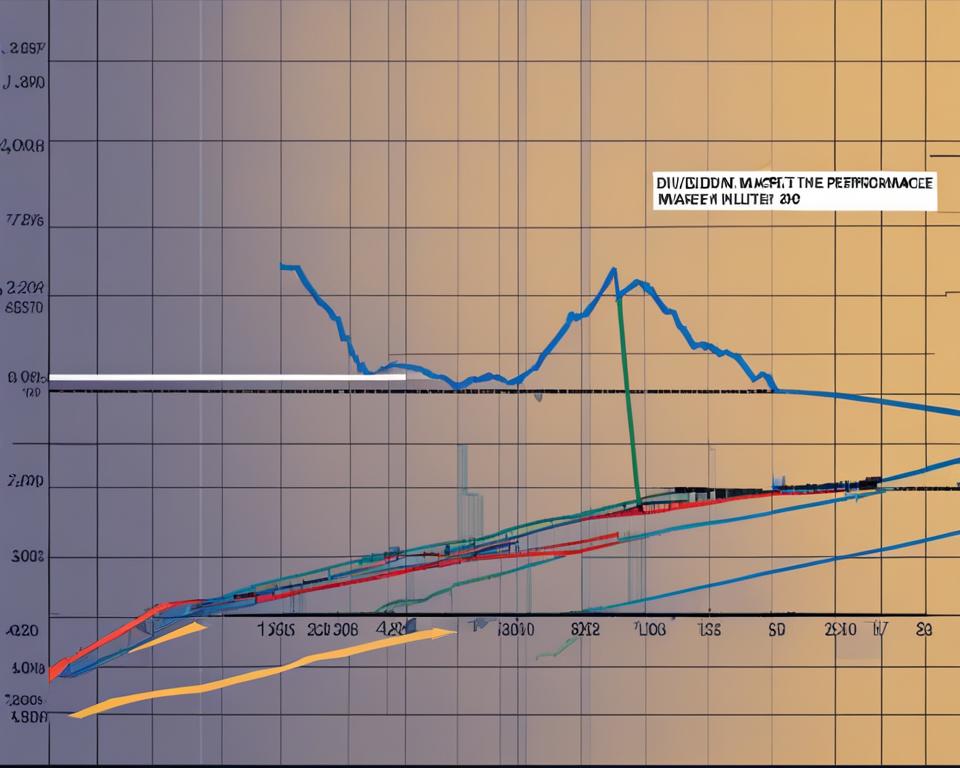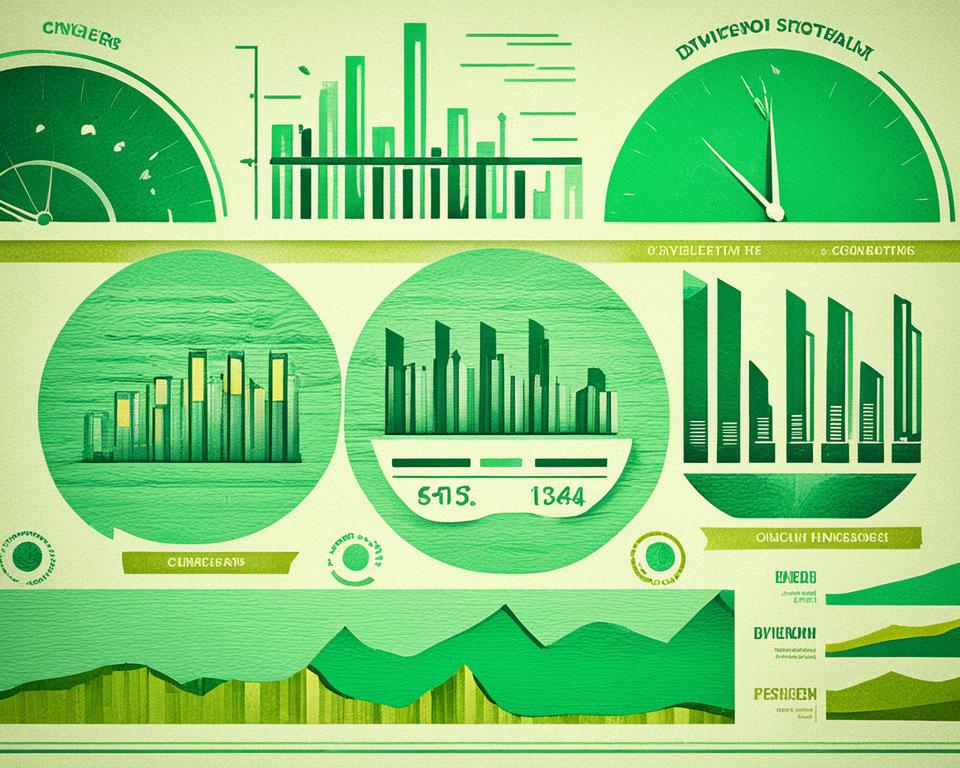The art of crafting an investment strategy that balances passive income generation with the pursuit of long-term growth is a nuanced endeavor. Sophisticated investors understand that to optimize dividend portfolios effectively, a blend of financial acumen and strategic foresight is required. A well-thought-out dividend income strategy sets the stage for a financial journey where income flows steadily and assets appreciate over time, providing a foundation for not just financial security, but prosperity as well.
Income investors are often guided by the desire to transform their portfolios into engines of passive income generation, using dividends as the consistent fuel. Yet, this does not imply a myopic focus on immediate returns. Rather, it’s a dual focus that includes long-term growth, ensuring that today’s investments will continue to bear fruit in the years to come. It takes patience, diligence, and a strong adherence to the principles of diversification and sound investment selection to optimize dividend portfolios, creating a steadfast stream of income and robust long-term asset appreciation.
Key Takeaways
- Effective dividend income strategies rely on a mix of current income and potential asset growth.
- A focus on high-quality, dividend-paying stocks can offer a hedge against market volatility and inflation.
- Investors need to prioritize companies with a history of stable and increasing dividend payouts.
- Reinvesting dividends is a potent method to compound wealth and reinforce income streams.
- Patience and continuous research underpin the success of any strategy seeking to optimize dividend portfolios.
Understanding Dividend Investing Fundamentals
The pursuit of dividend investing fundamentals extends far beyond the mere acquisition of stocks; it’s an intricate strategy aimed towards long-term financial fortitude. Insightful investors comprehend that dividends form an integral part of their investment portfolio, acting as both a cushion in turbulent markets and a vehicle for consistent income.
The Definition and Appeal of Dividends
At its core, the definition of dividends resonates with the concept of sharing a company’s earnings with its shareholders, usually in the form of cash payments or additional stock. These distributions are garnered from the profits and are reflective of a company’s financial health and commitment to returning value to its investors. The appeal of dividends is multi-faceted: they represent both a reward for the investors’ trust and a beacon of a company’s continued prosperity.
Evaluating Dividend Stocks for Portfolio Inclusion
When evaluating dividend stocks, one should consider a company’s dividend history and financial stability. A prudent investor will assess the dividend payout ratio and yield, eyeing a track record of not just consistent payments, but also increments in the dividend amount. These indicators suggest a sustainable business model capable of thriving under economic stress, making such stocks prime candidates for portfolio inclusion. It is this analytical rigor that ensures an income-generating portfolio balances immediate returns with future potential, cushioning against volatility while marching towards fiscal growth.
“The best dividends are not only those that are paid out regularly, but those that grow and adapt with a company’s success.”
The Scourge of Inflation on Fixed Income Investments
For individuals relying on fixed income investments, the persistent scourge of inflation poses a significant threat to maintaining the value of their income streams. With each uptick in the cost of living, the purchasing power of money from fixed income sources, such as bonds or certificates of deposit, gets systematically undermined, jeopardizing the investor’s financial stability and quality of life.
Diligent investors have, thus, been on the lookout for strategies to fortify their portfolios against this erosion of purchasing power. Inflation, if left unchecked or inadequately managed within an investment portfolio, can whittle away the returns, turning what seemed like a safety net into a financial pitfall.
Impact of Inflation on Dividend Yield and Purchasing Power
Inflation’s impact on dividend yield is a concern for income-focused investors. While fixed income investments offer a reliable payout, their nominal yield can be deceiving. As inflation rises, the real yield—what the yield is worth in terms of buying power—may fall. This decline means that the income generated may not be sufficient to cover the increased cost of living, making it imperative for investors to select investments that can potentially outrun inflation.
Balancing Income Generation with Inflation Risks
Properly balancing income generation with inflation risks requires a tactical approach to portfolio creation. It’s about marrying the necessity for steady income with the urgency to protect against the dynamism of the economy. Contemporary strategies often lean towards dividend-yielding stocks in well-established companies as a means to both secure a regular income and strive for asset appreciation that aligns with or exceeds inflation.
The dividends from these growth-oriented investments are the linchpin for investors striving to maintain, if not enhance, their living standards in the face of incessant inflation. In the dance of investment and inflation, it is the savvy and foresight in choosing the right partners—ones that not only weather the storm but also thrive—that ultimately dictates the investor’s financial rhythm.
To this end, incorporating stocks with a history of dividend yield growth is essential. These stocks are not just guarding against inflation but also promising an expanding stream of income, potentially leading to heightened purchasing power and assured financial solidity.
Analyzing Market Risks for Dividend Portfolios
Assembling a dividend portfolio that stands the test of time and economic variances demands a nuanced understanding of market risks. A robust dividend portfolio weathers the unpredictable nature of market forces by employing keen analytical strategies. These strategies revolve around the preemptive identification of potential economic risks that could impair the flow of dividends—an investor’s lifeblood for sustained financial growth.

Identifying Economic Factors Influencing Dividends
Navigating through a landscape marked by economic risks requires the capability to identify the economic factors at play. It’s these factors that often sway the consistency and size of dividend disbursements. From interest rate changes and inflationary pressures to geopolitical instability and sector-specific issues, recognizing these influential elements is imperative for the construction and maintenance of dividend portfolios designed to persist.
Strategizing to Mitigate Market Volatility Impacts
Strategic planning is key in mitigating the impacts of market volatility. Sensible asset allocation plays a pivotal role in insulating dividend portfolios from turbulent market swings and sector downturns. Investors should consider a blend of both equity and interest-bearing investments, putting them in a better position to manage the inconsistencies of market volatility, while still achieving their income generation aspirations. Additionally, giving precedence to companies with durable financial foundations enhances the likelihood of continuous dividend payouts, regardless of broader market fluctuations.
By employing meticulous and strategic analysis of market conditions and their dynamic nature, investors can adapt and realign their dividend portfolios to mitigate risks and capitalize on opportunities, ensuring a continuous stream of income and a shield against analyzing market risks.
Dividend Portfolios for Income Generation: Selection Criteria
When building dividend portfolios, the ultimate goal is income generation. However, achieving this goal requires adherence to a set of stringent selection criteria designed to identify the most promising dividend-paying stocks. Seasoned investors leverage these criteria to structure portfolios that not only generate income but also stand the test of time and economic shifts.
For a dividend portfolio to become a reliable source of income, diversification is key. A portfolio spread across various industries and sectors is less vulnerable to company-specific or industry-wide downturns. This diversification helps ensure that the flow of dividend payments remains stable, even when some segments of the market are underperforming.
To further this objective, here are several vital selection criteria:
- Financial Stability Over Growth: Opt for companies exhibiting robust financial health rather than those with the highest growth rates. This strategy often prioritizes established businesses likely to provide consistent dividends over time.
- Diverse Industry Representation: Aim to diversify across at least five to seven different industries to create a safety net against sector-specific risks.
- Pursuit of Firms with Rising Dividends: Select companies with a history of progressively increasing their dividend payments, which is suggestive of financial strength and a shareholder-friendly policy.
Dividend reinvestment plans (DRIPs) are another cornerstone of a strategic approach to income generation. By continually reinvesting dividends, investors can compound their returns over time, effectively increasing the earning potential of their portfolio.
In addition to the above considerations, examining payout ratios and leveraging reputable evaluation tools like the Value Line Investment Survey can provide deeper insights into potential investments.
| Criterion | Description | Significance for Income Generation |
|---|---|---|
| Financial Stability | Comparison of debt levels, cash flow, and earnings stability | Reduces potential for dividend cuts or eliminations |
| Dividend History and Growth | Evaluation of consistent and growing dividends over time | Indicates a commitment to shareholder value and increasing income streams |
| Industry Diversification | Allocation of assets across different sectors | Provides balance and mitigates sector-specific risks |
| Reinvestment Options | Availability of DRIPs or other reinvestment approaches | Facilitates the power of compounding and portfolio growth |
Investors should also consider how aligning with these criteria fits into their broader investment strategy. Decisions should be made within the context of personal financial goals, risk tolerance, and the economic environment. Through diligent selection and management of dividend reinvestment plans, investors can harness the full potential of dividend stocks for sustainable income generation.
Maximizing Returns with High Yield Stocks
In the quest for maximizing returns, high yield stocks present tantalizing opportunities. However, the allure of lofty yields must be carefully weighed against the potential risks. Navigating this delicate balance requires a discerning eye and a commitment to due diligence. An informed investor recognizes that opportunities without risks are rare, but by assessing financial health and adhering to stringent selection criteria, one can identify stocks that offer the prospect of sustained high returns.
Spotting High Yield Opportunities without the Risks
Finding high yield stocks that also promise safety and longevity in a portfolio is akin to discovering hidden gems. The search for these opportunities without risks is underpinned by a careful analysis of a company’s earnings stability, debt levels, and market position. Stocks with persistently high yields may indicate underlying issues, and therefore, thorough scrutiny becomes pivotal in illuminating the path towards genuinely fruitful investments.
Assessing Financial Health for Sustained High Returns
Assessing a company’s financial health is the cornerstone of investing in high yield stocks, as it directly informs the sustainability of returns. Critical factors such as credit ratings and payout ratios offer key insights into a company’s capacity to maintain and grow dividends. This financial health check ensures that investors can effectively dodge the yield trap, where a high dividend yield might be a precursor to a cut and declining prices.
| Parameter | Importance in High Yield Stock Assessment | Indicator |
|---|---|---|
| Dividend Yield | Provides initial measure of potential income | Current dividend rate as a percentage of stock price |
| Dividend Growth | Signals increasing shareholder value | Annualized increase in dividend disbursement |
| Payout Ratio | Assesses sustainability of dividends | Ratio of dividends to company’s earnings |
| Credit Rating | Indicates financial stability and health | Assessment by credit rating agencies |
| Debt to EBITDA | Measures leverage and repayment capacity | Company’s debt relative to its earnings |
By prioritizing financial solidity and steering clear of precarious dividend yields, investors can unlock the power of high yield stocks to bolster their pursuit of sustained high returns. This disciplined approach to selection is a testament to the tried-and-true investment wisdom of coupling high yields with robust financial health.
Building Passive Income Generation through Dividends
The path to building passive income is etched with the careful selection and management of income-producing assets, serving as the bedrock for financial independence. In the realm of investment, few strategies carry as much allure for steady earnings as the cultivation of passive income generation through dividends.

For those seeking to tap into the art of accumulating wealth without engaging in the daily grind, dividend-paying stocks have become synonymous with the clarity of a dividend payment schedule. This clarity ensures that investors can forecast and rely on a stream of income that is both predictable and stable.
An income stream bolstered by reinvesting dividends cultivates a fertile ground for the compounding effect to take root. It is within this financial strategy that dividends serve not as occasional windfalls, but as the recurring pulse of a portfolio designed to burgeon over time.
Mere ownership of stock does not end with the ringing of the closing bell. For savvy investors, it’s the initiation of an accumulation phase where the currency of patience yields high returns.
Dedication to detailed analysis and a commitment to adhering to a dividend payment schedule stand at the forefront of the investor’s strategy. The selection of robust and financially healthy companies—those that have demonstrated resilience even during economic downturns—ensures an income that not only sustains but grows.
| Key Component | Role in Income Generation | Investor’s Strategy |
|---|---|---|
| Dividend Frequency | Provides consistent income | Align portfolio with personal cash flow needs |
| Reinvestment | Fuels compounding growth | Maximize growth through DRIPs or other reinvestment plans |
| Stock Selection | Ensures dividend quality and sustainability | Choose stocks with a record of paying and growing dividends |
| Portfolio Balance | Minimizes risks, stabilizes returns | Diversify across industries and sectors |
In the journey toward building a tower of financial security, dividends represent not simply portions of a company’s profits but are the strategic elements wielded by the astute investor to generate a passive income stream. It is a journey marked not by leaps, but by the methodical layering of dividends—reinvested and meticulously allocated—one that leads to the summit of monetary independence.
The Power of Dividend Growth Investing
Dividend growth investing represents a tactical approach that has stood the test of time in generating wealth. It is a strategy that treats dividends not just as a source of passive income, but as a sign of a company’s commitment to returning value to shareholders. For those who prioritize dividend growers, they unlock the potential for long-term growth, hedging against market volatility and the insidious creep of inflation.
Prioritizing Dividend Growers for Long-Term Growth
Investing with a long-term perspective means prioritizing companies with consistent dividend growth. A focus on these dividend growers is crucial because their increasing payouts often reflect robust financial health and a potent catalyst for compounding gains. By selecting stocks with strong records of distributing higher dividends year after year, investors stand to create a fortress of sorts, one that shelters their wealth from market inconsistencies and the uncertainties of economic cycles.
The commitment to consistently growing dividends signals a company’s strength and investor-centric policies, laying the foundation for long-term capital appreciation.
Company’s Dividend History and Future Outlook Analysis
Analyzing a company’s dividend history and future outlook is akin to assessing its financial biography—scrutinizing past performance to predict future narrative arcs. An impressive dividend history often bodes well for a company’s future, particularly if its financials remain sound and its market position solid. By examining not just past dividend payments but also the strategic plans that might affect future payouts, investors gain insight into the sustainability of earning potential.
Highlighting the connection between a robust dividend history and promising future outlook, investors can gain assurance in their picks for dividend growth investing. It’s this seamless blend of historical performance and forward-looking analysis that creates an informed pathway towards realizing long-term growth.
Influential factors such as management’s capital allocation strategy and macroeconomic conditions play pivotal roles in determining whether a company can sustain and grow its dividends. Forward-thinking investors, therefore, prioritize entities that are not only performing well today but are poised to adapt and thrive in the years to come.
- Identification of dividend growers is rooted in a comprehensive analysis of financial fundamentals and earnings quality.
- Attention to industry trends and microeconomic forces ensures a realistic assessment of dividend sustainability and growth prospects.
- Integration of future outlook comes from understanding sector dynamics and company’s strategic positioning.
To harness the full potential of dividend growth investing, one must remain dedicated to continuous research and embrace a long-term outlook. In doing so, the investor strengthens their ability to discern between short-term noise and genuine growth opportunities, further solidifying their path to financial prosperity guided by the power of dividend growth investing.
Strategically Planning the Dividend Payment Schedule
Strategic planning in the realm of investment is paramount, especially when orchestrating a dividend payment schedule that suits individual financial rhythms. The aim is to scaffold a schedule providing steady income throughout the year. This is accomplished by selecting a cadre of stocks with varied dividend timelines—monthly, quarterly, and annually. An investor who strategically plans this schedule ensures that each month bears the financial fruit of a dividend payout.
Utilizing dividend reinvestment plans (DRIPs) further complements the strategic planning of a dividend payment schedule. DRIPs allow the opportunity to methodically grow an investor’s holdings by automatically reinvesting dividends into additional shares, which can pay forward in increased dividend gains over time. This natural amalgamation of strategic planning and DRIPs plays a pivotal role in the sphere of dividend growth investing, providing a foundation for both immediate cash flow and the promise of enhanced future capital.
To illustrate the effectiveness of a finely tuned dividend payment schedule, consider a sample portfolio incorporating a balance of assets with varying dividend schedules:
| Asset Type | Dividend Frequency | Contribution to Cash Flow |
|---|---|---|
| REITs | Monthly | Consistent monthly income, compounds if reinvested |
| Blue-chip Stocks | Quarterly | Stable, predictable payments throughout the year |
| Bonds | Semi-annually | Typically larger, less frequent injections of cash |
| Special Dividend Stocks | Variable/Annually | Added bonus income with potential for reinvestment |
In this punctiliously planned schema, the investor not only relishes in a regular cash flow but also molds a resilient framework against fiscal uncertainty. This approach plays a vital instrument in the advancement of dividend growth investing—going beyond simplistic yield pursuits to a choreographed strengthening of economic endurance.
Remember, strategically planning the dividend payment schedule operates on the core principle of financial synchronization—where dividends are not seen merely as sporadic influxes but as calculated pulses that maintain the investor’s financial health.
Incorporating Income Producing Assets Outside of Stocks
In the domain of investment, diversification is not a mere option but a strategic imperative. The savvy investor, in pursuit of financial stability and sustained passive income, often looks beyond the stock market. By incorporating income-producing assets such as real estate investment trusts (REITs) and bonds, one can capitalize on alternative dividend-generating vehicles, resulting in a well-rounded and resilient portfolio poised for long-term success.
Alternative Dividend-Generating Vehicles
Exploring avenues outside of equities, investors discover a host of income sources that can add a significant buffer to their financial endeavors. Alternative dividend-generating vehicles such as master limited partnerships (MLPs) and preferred stocks provide not only potential tax advantages but also diversify the sources of income. Preferred stocks, in particular, offer priority dividend payments, potentially increasing an investor’s yield compared to common stocks.
Moreover, allocating a segment of an investment portfolio to income-generating assets like dividend mutual funds and exchange-traded funds (ETFs) that are specifically designed for income can expose an investor to a basket of dividend-paying companies with a single investment, mitigating the risks of large capital investments in single entities.
Integrating REITs and Bonds for Diversification
REITs, entities that own and usually operate income-producing real estate, are mandated by law to distribute a majority of their earnings as dividends to shareholders. This requirement makes REITs a compelling consideration for those looking to incorporate alternative sources of income into their portfolios. Additionally, as the real estate sector often moves differently compared to more traditional stocks, REITs can be a valuable tool in achieving portfolio diversification.
Bonds, on the other hand, offer another layer to an investor’s income stratum. Whether corporate, municipal, or government bonds, these instruments provide scheduled interest payments, generating a predictable income flow. Through the use of bonds, an investor can mitigate the effects of stock market volatility and secure a steady income, even during economic downturns.
When actively incorporating income-producing assets such as REITs and bonds, or delving into alternative vehicles like MLPs or preferred stocks, an investor not only aims to enhance their income potential but also achieves a measure of protection against the unpredictable nature of the markets. Such a strategy stands as a testament to the adage of not putting all your eggs in one basket, and in the complex world of investments, it’s this diversification that often leads to a robust and enduring portfolio.
Advantages of Dividend Reinvestment Plans (DRIPs)
When it comes to investing in dividends, the strategic use of Dividend Reinvestment Plans (DRIPs) can be a game-changer for portfolio growth. A deeper understanding of DRIPs and their ability to power up an investor’s portfolio is crucial to appreciating their place in a savvy investor’s toolkit. Let’s dissect the distinct advantages these plans provide, and why they’re considered pivotal tools for long-term investment success.
Understanding DRIPs and Their Benefits
Understanding dividend reinvestment plans starts with recognizing them as automated strategies that convert dividend payouts back into additional shares of the issuing company, instead of taking them as cash. This reinvestment bolsters the investor’s share count and capitalizes on the principles of compounding, amplifying portfolio growth over time. Essentially, the benefits of DRIPs lie in their capacity to incrementally increase an investor’s stake in the company, often without commission costs, thus aligning perfectly with a cost-effective wealth-building strategy.
Accelerating Portfolio Growth through Reinvesting Dividends
By consistently reinvesting dividends, investors inadvertently set the stage for accelerating portfolio growth. The magic of DRIPs is in their potential to transform modest dividend payments into sizable portfolio enhancements. Over time, the effect of reinvesting can be dramatic—the number of shares an investor holds can swell significantly, with each additional share potentially generating its own dividend payouts in the future.
The following table illustrates hypothetical growth facilitated by a DRIP, showcasing its potential impact on an investor’s portfolio:
| Year | Shares Held at Start | Annual Dividend Per Share | Total Dividend Received | Shares Purchased through DRIP | Total Shares after DRIP |
|---|---|---|---|---|---|
| 1 | 100 | $2 | $200 | 10 | 110 |
| 2 | 110 | $2 | $220 | 11 | 121 |
| 3 | 121 | $2 | $242 | 12.2 | 133.2 |
| 4 | 133.2 | $2 | $266.4 | 13.3 | 146.5 |
In the table, notice how each year’s dividends, when reinvested, increment the total shares held, effectively generating a larger dividend the subsequent year. This cycle solidifies DRIPs as a compelling choice for those targeting the advantages of DRIPs—a seamless melding of receiving and reinvesting dividends to perpetually augment their investment base.
For investors who prioritize sustainability and advancement in their portfolios, the benefits of dividend reinvestment plans are clear. By reinforcing the core philosophy of reinvestment with the practicality of DRIPs, they set forth a trajectory aimed at long-term prosperity facilitated by an ever-increasing stream of dividends and shares.
Dividend Income Strategy Amidst Changing Economic Conditions
Amidst the ever-evolving landscape of the global economy, investors are compelled to refine their dividend income strategy to navigate the unpredictable tides of changing economic conditions. Adaptability and vigilance become key traits as they strive to safeguard their portfolio’s resilience, ensuring that market perturbations do not derail their income generation objectives.
Adapting Portfolio to Counter Economic Fluctuations
As economic fluctuations become more pronounced, the process of adapting one’s portfolio becomes increasingly critical. This adaptation is not about reactive shifts in response to market noise but rather a proactive, strategic response to genuine economic trends. By reassessing asset allocations and being responsive to the economic indicators, astute investors can maintain a robust dividend income strategy that remains resilient in the face of adversity.
Investors who adapt their portfolios to the economic environment demonstrate prudence, understanding that flexibility is paramount to thriving in a dynamic economic climate.
Rebalancing Strategies for Dividend Portfolios
The cornerstone of sustaining a dependable dividend income strategy in fluctuating economies is the application of rebalancing strategies. Such strategies entail a periodic review of the portfolio to realign the proportion of various asset classes in accordance with one’s investment goals and the prevailing market conditions. Reconciling risk tolerance with income needs while managing exposure to economic sectors prone to volatility marks the essence of a sound rebalancing strategy.
| Rebalancing Action | Purpose | Impact on Dividend Portfolio |
|---|---|---|
| Adjusting stock-to-bond ratio | Manage risk during volatile markets | May increase stability of income stream |
| Shifting industry sector weightings | Respond to sector-specific economic shifts | Mitigates sector risk, diversifying income sources |
| Increasing weight in dividend growers | Hedge against inflation and economic downturns | Potentially higher future payouts that beat inflation |
| Consolidating positions | Eliminate underperformers, focus on stability | Improves quality of income and reduces portfolio drag |
| Introducing international diversification | Capitalize on global market opportunities | Chances of enhanced yield from different economies |
In enacting these rebalancing strategies, investors must balance the pursuit of high yields with the imperative of minimizing risks. The complexity of aligning a dividend income strategy with the unpredictable nature of changing economic conditions calls for a judicious yet dynamic approach towards portfolio management. Through continual portfolio evaluation and adaptation, investors can make prudent choices that position them well for whatever economic weather lies ahead.
Optimizing Diversification in Dividend Portfolios
A strategic approach to optimizing diversification in dividend portfolios entails spreading investments across a dynamic range of industries and sectors. This breadth offers investors the advantage of mitigating risk while positioning their assets to capture growth across the economic spectrum. It is by embedding industry diversification and sector diversification into the core of their investment strategies that investors can fortify their portfolios against isolated economic downtrends.
Benefits of Industry and Sector Diversification
The methodical pursuit of industry diversification within dividend portfolios introduces a layer of insulation against industry-specific volatilities. Investors looking to optimize their dividend flows elevate their resilience by investing across a spectrum of sectors – from the steadfastness of utilities and consumer goods to the innovative vigor of technology and healthcare. Sector diversification also plays a pivotal role, weaving a diversified financial tapestry that can both absorb economic shocks and capitalize on sector-specific growth opportunities.

Minimizing Risks Through Strategic Allocation
The art of minimizing risks in dividend portfolios is underpinned by strategic allocation, a disciplined approach that balances asset distribution in alignment with current market conditions and future forecasts. This entails a judicious selection of assets, investing in high-yield opportunities while maintaining a balanced exposure to provide steady income and preserve capital. Such careful allocation is a testament to the investor’s commitment to optimizing diversification, ensuring a stable foundation for both the present and the future of their investments.
- Strategically allocating investments to different industries reduces the impact of single-sector downturns.
- Combining high dividend yield stocks with the security of sector-spanning assets enhances portfolio strength.
- Maintaining a vigilant stance on market fluctuations ensures timely rebalancing, aligning with strategic allocation objectives.
- Periodic evaluation and reallocation safeguard the portfolio against emerging risks and capitalize on growth sectors.
Understanding the interplay of industry and sector dynamics is crucial for optimizing dividends and safeguarding the investment journey. A clear eyed-strategy, focused on diversification and strategic allocation, empowers investors to weather unpredictability, ensuring sustained dividend income and a robust portfolio.
Taking a Pragmatic Approach: Safety and Stability First
Investors who execute a pragmatic approach to dividend investing emphasize safety and stability, prioritizing the stock safety margin as a key measure of a company’s resilience. By carefully assessing stock safety through these lens, they can pinpoint robust investment opportunities with desirable yields without exposing their portfolios to undue risk. This methodical assessment is crucial in finding balance yield and safety, acting as an anchor amidst the unpredictable swells of the market.
Assessing a Stock’s Safety Margin before Investment
Assessing a stock’s safety margin involves examining the company’s financial health, with particular attention to its balance sheet strength. This scrutiny enables investors to identify stocks with a solid foundation, typically those providing yields between 4 to 5% or higher. A company’s ability to consistently pay and potentially grow its dividends speaks to the core of what it means to invest pragmatically—seeking reliable returns while safeguarding capital.
| Financial Indicator | Description | Relevance to Stock Safety Margin |
|---|---|---|
| Debt-to-Equity Ratio | A measure of a company’s financial leverage | Lower ratios point to less financial risk and higher safety margins |
| Free Cash Flow | Cash produced through operations after capital expenditures | Indicates the company’s ability to sustain and grow dividends |
| Payout Ratio | Portion of income given to shareholders as dividends | Lower payout ratios suggest dividends are well-covered and more stable |
Finding the Balance Between Yield and Safety
To effectively find the balance between yield and safety, investors must reconcile the allure of high dividend yields with the pragmatic need for stability. This equilibrium is maintained by selecting high-quality stocks that offer attractive returns with minimal risk. The goal is to avoid the yield trap, wherein investors are drawn to unsustainable high yields, ultimately compromising portfolio stability and long-term growth.
- Evaluate historical performance and ensure consistent dividend growth.
- Favor companies with transparent earnings reports and robust corporate governance.
- Consider both macroeconomic factors and sector-specific outlooks to anticipate future performance.
By adopting these disciplined investment tactics, the pragmatic investor navigates the sometimes tempestuous market waters, grounded in a strategy that prizes safety and stability above fleeting gains. The result is a portfolio that can not only generate income but also withstand the test of time.
Practical Steps to Setting Up a Successful Dividend Portfolio
Embarking on the journey of setting up a dividend portfolio requires a methodical approach sprinkled with strategic insight. For investors aiming to fuel their financial futures with passive income generation, structuring a portfolio to include a broad range of high-yield stocks is paramount. This type of portfolio acts not only as a beacon of stability in the choppy waters of the market but also as a vessel steadily progressing towards affluent harbors.
Firstly, diversification stands as a pivotal pillar in the architecture of a robust dividend portfolio. Spreading investments across various industries cushions the portfolio against the whims of market volatility. This heterogeneity in holdings ensures that even if one segment underperforms, the collective strength of other sectors sustains the income flow.
- Invest in a mix of sectors such as utilities, healthcare, consumer goods, and technology to tap into the potential of different market dynamics.
- Adopt dividend reinvestment plans (DRIPs), allowing dividends to purchase more shares, thus fueling the growth engine of your portfolio with minimal effort on your end.
Here are some additional, key steps:
- Financial Stability: Prioritize companies that exhibit a solid financial backbone, as they are more likely to sustain dividend payouts during economic downturns.
- Payout Ratios: Look for corporations with modest payout ratios; those that retain a large portion of their profits tend to have more resources to weather financial setbacks and grow their dividends.
- History of Dividend Growth: Choose stocks with a demonstrable record of increasing dividends. Such a history often points to a well-managed company with a shareholder-friendly approach.
A carefully constructed dividend portfolio merits continual refinement. The art of portfolio management is not static but dynamic, requiring investors to be vigilant and proactive. Monitoring market trends, analyzing economic indicators, and staying informed about specific companies’ performances will serve as vital components of successful passive income generation.
To illustrate these concepts, consider the following structured approach:
| Step | Action | Objective |
|---|---|---|
| 1 | Research and select diversified industries | Spread risk across stable and growing sectors |
| 2 | Evaluate financial stability | Identify companies capable of consistent dividend payouts |
| 3 | Analyze payout ratios | Ensure dividends are sustainable and not eroding earnings |
| 4 | Check dividend growth history | Focus on stocks with a pattern of increasing dividends |
| 5 | Use DRIPs | Leverage compounding to accelerate portfolio growth |
When choosing the individual components of your dividend portfolio, bear in mind that while high yield stocks tempt with their impressive returns, they must be carefully vetted for underlying stability. The key to unlocking the power of these potential portfolio stalwarts is a combination of diligent research, patience, and unwavering attention to detail—traits that every successful dividend investor should embody.
“By conscientiously adhering to these practical steps, the diligent investor can construct a dividend portfolio that not only supports passive income generation in the near term but also promises sustainable capital appreciation for the future.”
In summary, laying down a robust foundation for a dividend portfolio calls for an investment in knowledge and an understanding of how to weave together a mosaic of high yield stocks and other income-bearing assets. Remember, the dividends you reap today are the seeds of your financial abundance tomorrow.
Conclusion
In summary, the journey through the multifaceted world of dividend investing brings us to a singular, pivotal nexus: the balancing act between fostering immediate income generation and nurturing long-term growth. True mastery in the arena of dividend portfolios demands a harmonious blend of these two objectives, constructed with the bricks of in-depth research and the mortar of unwavering patience. Investors who find this equilibrium are well on their way to sculpting financial legacies that endure the tests of time and market volatility, progressively building towards a fusion of prosperity and stability.
The Balancing Act: Income Generation vs. Long-Term Growth
The quest for optimal income does not forsake the allure of burgeoning asset appreciation. Instead, it seeks to unify the two in a harmonious financial symphony. This balancing act requires strategic foresight to select dividend-bearing stocks that not only alleviate the immediate financial strain but also promise lucrative vistas of capital expansion. Seasoned investors navigate this interplay, harnessing the dual powers of consistent dividends for immediate needs and capital gains for future growth.
Emphasizing Research and Patience in Dividend Investing
Dividend investing is encapsulated not by spur-of-the-moment decisions, but by a tapestry of diligent research and the steady hand of patience. It is through meticulous investigation into market trends, company histories, and economic forecasts that an investor can sow the seeds for a thriving dividend portfolio. Such a methodical approach, coupled with the patience to invest in compound growth, lies at the heart of success in generating substantial and sustainable returns. In the realms of income generation and long-term asset growth, it remains an irrefutable conclusion that patience, paired with methodical research in dividend investing, pave the road to financial sovereignty.
FAQ
How can investors optimize their dividend portfolios for income generation and long-term growth?
Investors can optimize their dividend portfolios by diversifying across various industries and sectors, selecting stocks from companies with a history of stable and growing dividends, and implementing dividend reinvestment plans (DRIPs). Emphasizing both income generation and long-term growth, investors should also pay attention to company financials to ensure a balance between a secure yield and portfolio growth prospects.
What are the fundamentals of dividend investing?
Dividend investing involves selecting companies that provide regular shareholder payouts, which are portions of a company’s profit. Fundamentals of dividend investing include understanding the sustainability and growth potential of dividends, considering the financial health of the companies, and evaluating the stocks for potential inclusion in a diverse investment portfolio.
Why is it important to evaluate dividend stocks for portfolio inclusion?
Evaluating dividend stocks is crucial as it helps ensure that an investment will provide a reliable and potentially growing income stream. This evaluation should include assessing a company’s track record in paying dividends, its financial stability, and the dividend payout ratio to sustainably balance investment growth with income generation.
How does inflation impact dividend yield and an investor’s purchasing power?
Inflation can erode the purchasing power of the money investors receive from dividends by increasing the cost of goods and services. Therefore, even if a dividend yield remains consistent, the actual value of that income may decrease over time if inflation rates are high.
What strategies can investors employ to mitigate the impacts of market volatility on dividend portfolios?
To mitigate market volatility, investors should diversify their portfolios across various asset classes, industries, and geographic locations. They can also focus on investing in companies with strong fundamentals and a history of weathering economic downturns. Following a disciplined investment strategy and not making impulsive decisions based on short-term market movements can also be beneficial.
What are some selection criteria for building a dividend portfolio for income generation?
Key selection criteria include diversification across different sectors and industries, choosing stocks from companies with a consistent track record of paying and increasing dividends, examining payout ratios to ensure sustainability, and implementing dividend reinvestment plans to grow the investment over time.
How can investors spot high yield opportunities without taking on too much risk?
Investors can spot high-yield opportunities by conducting thorough research on companies’ financial health, avoiding those with unsustainable high yields, and looking for companies with strong credit ratings, stable earnings, and modest payout ratios. Focusing on industries less prone to dividend cuts can also help manage risk.
What are some practical tips for building passive income generation through dividends?
Building passive income through dividends involves selecting dividend-paying stocks with a history of growth, reinvesting dividends to take advantage of compounding, and creating a well-balanced portfolio that can provide consistent payouts through various market conditions. Strategic planning of the dividend payment schedule also ensures a steady income stream.
How can investors use dividend growth investing for long-term portfolio growth and stability?
Investors can use dividend growth investing by prioritizing companies that have a strong history of increasing their dividends consistently. This approach favors long-term growth and stability, as these companies are often financially robust and may perform better over the long-term, providing an increasing income stream that can keep pace with or exceed inflation.
What are alternative dividend-generating investments outside of stocks?
Beyond stocks, investors can look into real estate investment trusts (REITs), bonds, and other fixed income securities that provide regular interest or dividend payments. These alternatives can diversify income sources and reduce risk in a dividend-focused portfolio.
What advantages do Dividend Reinvestment Plans (DRIPs) offer?
DRIPs offer the advantage of automatically reinvesting dividends into buying more shares of the underlying stock or fund, often without transaction fees. This can accelerate portfolio growth through compounding, allowing investors to increase their investment without additional out-of-pocket funds.
How should dividend income strategies adapt to changing economic conditions?
Dividend income strategies should adapt to changing economic conditions by regularly reviewing and potentially rebalancing the portfolio to respond to economic shifts. This may involve adjusting the mix between sectors, industries, and individual securities to better position for stability and income generation regardless of economic conditions.
Why is diversification important in optimizing a dividend portfolio?
Diversification is important because it spreads risk across various industries and sectors, ensuring that the portfolio is not overly reliant on any single area. This can help maintain stable income streams even when certain markets or sectors are underperforming.
How can investors strike a balance between finding a safe yield and securing investment growth?
Investors can strike a balance by carefully researching and selecting companies with solid financials and a history of sustainable dividend payments. They should look for a reasonable yield—typically in the range of 4 to 5%—that is supported by the company’s earnings and business model, rather than chasing the highest yields which may not be sustainable.
What are some steps to setting up a successful dividend portfolio?
Steps to setting up a successful dividend portfolio include diversifying across multiple industries, choosing financially stable companies, seeking manageable payout ratios, finding companies with a penchant for raising dividends, reinvesting dividends, and continuously scouting for worthy income-generating investments.
How do investors balance the need for immediate income with the goal of long-term growth in their dividend portfolios?
Balancing immediate need for income with long-term growth involves a mix of selecting dividend-paying stocks that offer a stable and immediate income stream with those that have potential for capital appreciation and dividend growth over time. Investors should focus on sustainable, growing companies and reinvest dividends wherever possible to compound growth.












